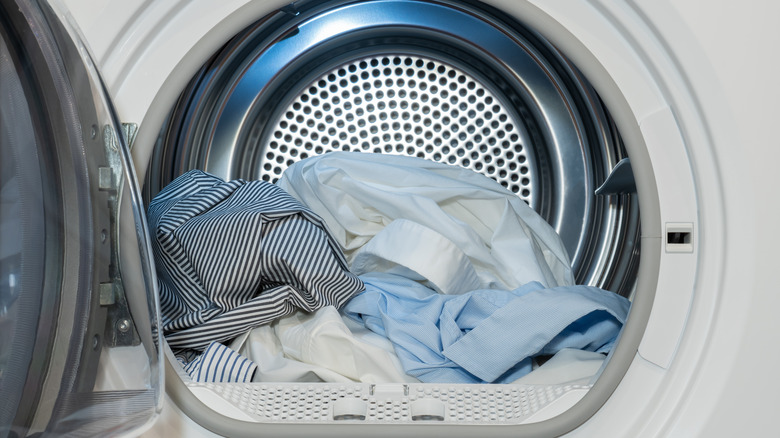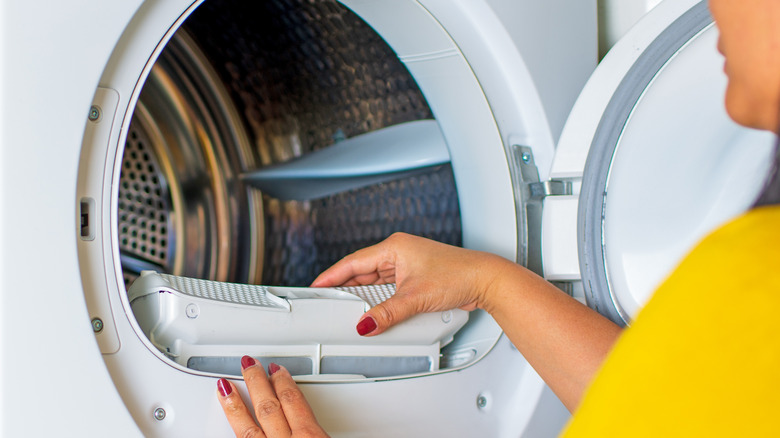Signs Your Dryer Needs Repairs, According To An Expert
The dryer can be a frustrating piece of equipment. The appliance adds incredible efficiency to your routine — when it's working. But minor issues can present themselves without warning and drastically reduce the value it brings to your laundry room. Naturally, your dryer has a limited lifespan, and as your unit ages, it becomes less effective at returning clothing to an immediately wearable state. It may even show signs of becoming a fire hazard if lint is allowed to build up inside the drum or within the exhaust vents. Of course, receiving maintenance and repairs is often an option, just like any other home feature. However, identifying exactly when to call a professional can be tricky.
In an exclusive interview with House Digest, Dennis Godynuk of Comfort Appliance Repair in Covington, Georgia, discusses some of the telltale signs that your dryer has seen better days and offers some key insights to help pinpoint the issues plaguing your unit. The machine remains an essential feature of an efficient life, so getting the repairs you need in a hurry should be a priority for anyone experiencing trouble in the laundry room.
Strange noises and smells
The first sign that your unit is experiencing trouble often comes through auditory and nasal cues. "Unusual noises coming from your dryer can be a sign of serious trouble inside the machine. From squeaks and thumps to banging sounds, these noises could indicate that something needs to be repaired or replaced in order for your dryer to work properly," Godynuk says. Some noises may even suggest that moving parts have come loose within the unit, leaving your dryer susceptible to costly damage.
Of course, noises aren't the only indication that something is wrong. Given how dirty or damaged dryers are far more prone to causing fires than a brand-new unit, you'll want to trust your nose if it detects something is awry. "If you start to notice a burning smell coming from your dryer, it could be an indication of an electrical issue such as a faulty wiring job or damaged heating element. In this case, it is important to shut off the machine immediately and contact a professional for help with a repair. Continuing to use your dryer while there is an electrical issue can put yourself and others at risk of harm, so it is imperative that the problem is addressed quickly," Godynuk says.
It's not drying efficiently
A dryer that's on the fritz might tempt an owner to run multiple cycles in order to finish the job. This shouldn't be your standard procedure, however. Redrying clothes puts increased strain on an already limping appliance by running the system more often than is strictly necessary. Over the long run, the use of multiple cycles also adds significantly to your electricity bill and can degrade the unit's internal components. "Clothes should generally be completely dry after just one cycle," Godyunk says. "If they are taking an abnormally long time to dry, it could be an indication that one or more of the parts within your dryer needs repairs. Common offenders include a malfunctioning heating element or timer switch."
Drying performance can be affected by a few issues within the unit. "Clothes that come out damp could mean that the dryer's components have worn out and need to be replaced or that the venting system is blocked," says Godyunk. "A blocked venting system can cause your machine to overwork as it struggles to expel hot air, resulting in clothes remaining damp even after a full cycle." If the exhaust system is blocked, the unit may contribute to an increase in retained moisture in the vent pipe. If left long enough, this may invite mold into your laundry room.
Your machine won't turn on
A completely dead appliance is a picture-perfect candidate for repairs. Fortunately, the catalog of problems that can cause your dryer to simply shut down is slim and often found within mechanical components. "If your dryer won't turn on, there may be a problem with the motor or ignition switch. Other causes could include a worn-out door switch, defected timer, or a faulty belt," Godyunk says. Replacing one or more of these parts can be accomplished quickly, bringing your dryer back into working order with a simple diagnosis and swap.
If your dryer is still in the early phase of its lifecycle, repairing the appliance is probably your best course of action. Shopping for a new dryer can be costly, so calculating the likelihood of additional years of service and the repair cost against the price of a new unit can help you make this decision confidently. However, none of this is possible without identifying the problem in the first place. "In any case, it is important to identify the source of the issue and have repairs carried out quickly to prevent more potential damage," Godynuk says.



